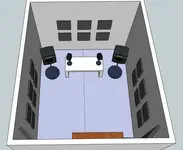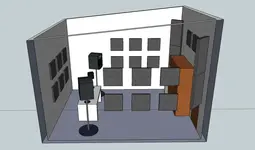F
ffrgtm
New member
Hello everyone,
Working in a little room where me and at least one professional like to dj on the week nights. Located in an area where sound containment isn't an issue... but as you can see the room is medium sized and quite tall, with a sloping ceiling (room dimensions are symmetrical so understand that the ceiling when viewed from the x,z plane is a line) so the reverberations in the room are horrible. The floor is carpeted but everything else is a hard surface.
I'm unsure what the proper orientation is for the table, there are two 8" monitors on it for the dj and I have a kef downward firing subwoofer (from a home stereo) under the table. Also have 2 15" pa speakers facing away from the table. Realize that all of this can be moved around per recommendations .
To deal with this issue, I have built 18 2'x4' 2" thick bass traps with rock wool. I decided to only go with the 2" so I could afford to build 18 of them... I have a lot of surface area to work with here.
I am also capable of putting blankets on the walls/ceiling to help with the higher frequencies.
Can anyone help me with the orientation of the speakers and basstraps to get the best sound for both the dj and listeners in the room?
Thank you all very much for your help... I spent a little time making this sketchup model to make myself easier to understand.
Working in a little room where me and at least one professional like to dj on the week nights. Located in an area where sound containment isn't an issue... but as you can see the room is medium sized and quite tall, with a sloping ceiling (room dimensions are symmetrical so understand that the ceiling when viewed from the x,z plane is a line) so the reverberations in the room are horrible. The floor is carpeted but everything else is a hard surface.
I'm unsure what the proper orientation is for the table, there are two 8" monitors on it for the dj and I have a kef downward firing subwoofer (from a home stereo) under the table. Also have 2 15" pa speakers facing away from the table. Realize that all of this can be moved around per recommendations .
To deal with this issue, I have built 18 2'x4' 2" thick bass traps with rock wool. I decided to only go with the 2" so I could afford to build 18 of them... I have a lot of surface area to work with here.
I am also capable of putting blankets on the walls/ceiling to help with the higher frequencies.
Can anyone help me with the orientation of the speakers and basstraps to get the best sound for both the dj and listeners in the room?
Thank you all very much for your help... I spent a little time making this sketchup model to make myself easier to understand.



 Who are you DJ'ing for anyway?
Who are you DJ'ing for anyway?


 In these situations people seem to prefer to be packed in a small space, that way it's harder for people to make out the ridiculous arm flopping they're trying to pass off as dancing (myself included). Would it be wise for me to double my material and go 4" thick and just throw half of my frames away? I was planning on using blankets on the walls for "diffusion". How important is it to set the table up lengthwise?
In these situations people seem to prefer to be packed in a small space, that way it's harder for people to make out the ridiculous arm flopping they're trying to pass off as dancing (myself included). Would it be wise for me to double my material and go 4" thick and just throw half of my frames away? I was planning on using blankets on the walls for "diffusion". How important is it to set the table up lengthwise?
